Hello lovelies!
I have a secret for you: I am obsessed with my hair. And I’m sure I’m not alone!
Indeed, according to a survey carried out in 2018 by the magazine InStyle, 81% of women reported that they feel the most confident when their hair looks great. Also, 72%of women said that feeling good about their hair was empowering.
And these results shouldn’t be surprising! Indeed, healthy and shiny hair is often seen as a sign of beauty and vitality. And this is true in every culture. Achieving this can sometimes feel challenging. Indeed, factors such as environmental damage, stress, and the use of harsh hair products are stressful to women’s hair.
However, with the right care and attention, anyone can improve the health and appearance of their hair. In this article, I will show 10 simple and actionable tips for achieving healthier and shinier hair.
Disclaimer: This post contains affiliate links to help me support this blog. I may earn a commission whenever you click on the links and purchase the products, with no additional cost to you. Thanks in advance for your support!
Healthier and Shinier Hair Tips: Understanding Your Hair Type and Texture

Before achieving shiny and healthy hair, you must understand your hair type and texture. Indeed, this will enable you to understand your hair’s specific needs. Moreover, it will help you craft a customized routine adapted to your texture.
For instance, I have afro hair with a tight curly texture. But my best friend who is of Chinese descent has straight hair. And she was very surprised to see that I didn’t wash my hair as often as she did. But that’s just because our hair textures and types are different!
If you need detailed information about hair type, texture, and the associated needs to each of them, check out this article. You can also read the book Andre Talks Hair by Andre Walker for better insight on this matter.
Healthier and Shinier Hair Tips: Establishing a Gentle Washing Routine
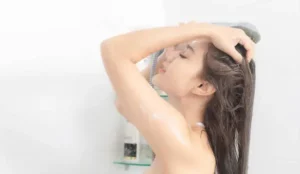
A gentle washing routine is essential for maintaining healthy and thinly hair. Here are some guidelines to help you establishing a gentle washing routine adapted to your hair.
Choose the right shampoo and conditioner
Choosing the right shampoo and conditioner for your hair type can make a significant difference in its health and appearance. Here are some tips for choosing the right hair products for you.
- Know Your Hair Type: Determine whether your hair is oily, dry, or normal. Then, choose your hair products accordingly.
- Avoid harsh chemicals: Look for shampoos and conditioners free of sulfates, parabens, and other harsh chemicals. Indeed, they can strip your hair of its natural oils. For example, you may even opt for natural shampoos such as ayurvedic powders (shikakai, aritha) or clays.
- Look for moisturizing ingredients: Ingredients like aloe vera, argan oil, and coconut oil hydrate and nourish your hair.
Using the right hair products can help to maintain the natural moisture balance of your hair.
Avoid Over-Washing Your Hair
Washing your hair too frequently can strip it of its natural oils. Thus, the leads to dryness and dullness. Here are some tips for washing your hair properly.
- Find the right washing frequency for you: Depending on your hair type, you may only need to wash your hair 2-3 times a week. For instance, I found out that washing my hair 1-2 a week was ideal for me – and I have afro hair!
- Dry Shampoo: Use dry shampoo in between washes. This will help you keep your hair looking fresh without over-washing. In particular, I recommend this tip for the ladies who have oily hair.
Finding the right balance for washing your hair can help maintain its natural oils, keeping it healthy and shiny.
Cold or warm water: what’s best for your hair?
Washing your hair at the right temperature can make a significant difference for your hair. Indeed, very hot water can strip your hair from its natural oils. Thus, your hair will look dull and brittle in the long run.
What I advise would be an old-school tip. You can start by washing your hair with warm water, and finish with a final splash of cold water.
Indeed, warm water will get rid of all the dirt from your hair and scalp. Also, it will open your cuticles to help you wash your hair and scalp thoroughly, while stimulating your blood flow to cuticles for better hair growth.
On the other hand, a cold water final rinse will close your cuticles and add more shine to your hair. It will also ensure your hair stay clean longer, making it less vulnerable to oil, grease, and dirt.
Now you know why you must combine both temperatures!
Healthier and Shinier Hair Tips: Nourishing From Within or the Nutrition’s Role in Hair Health

Ladies, healthy and shiny hair starts from within. A balanced diet rich in essential nutrients is crucial for hair health.
Eat Essential Nutrients For Hair Health
- Protein: Hair is primarily made of protein. Therefore, consuming enough of it is essential. Include lean meats, fish, and eggs in your diet. If you’re a vegetarian/vegan, adding beans, peas, and nuts in your diet is not negotiable!
- Omega-3 Fatty Acids: These healthy fats help to keep your scalp healthy. Sources include fatty fish, flaxseeds, chia seeds, and walnuts.
- Vitamins and Minerals: Vitamins A, C, D, and E, zinc, and iron play a crucial role in hair health. Eat a variety of fruits, vegetables, whole grains, and lean meats to ensure you’re getting these nutrients.
- Hair Supplements: For those who don’t have a balanced diet, or who want to boost their hair growth, I have the solution you need. Indeed, you can start a cure of hair supplements to help you achieve your hair goals. Personally, I have a 3-month cure of dedicated hair vitamins in spring and fall. They should contain nutrients such biotin and MSM.
By maintaining a balanced diet, you can support your hair’s health from the inside out. This will lead to stronger and shinier hair strands.
Stay Hydrated
Hydration is essential for maintaining the health and shine of your hair. Just like your skin, your hair needs water to stay hydrated.
But how can you stay hydrated? First, drink plenty of water. Aim for at least 8 glasses of water per day. Moreover, you can eat plenty of hydrating foods. For instance, you may include water-rich foods in your diet: cucumbers, watermelons, orange, and strawberries.
Healthier and Shinier Hair Tips: The Importance of Regular Trims
Regular hair trims are essential for keeping your hair healthy and preventing split ends. Aim to trim your hair every 6-8 weeks to remove split ends and keep your hair looking fresh.
Regular trims help to maintain the overall health of your hair. Therefore, your hair will appear shinier and more vibrant.
Healthier and Shinier Hair Tips: Protecting Hair from Heat Damage
Frequent use of heat styling tools like blow dryers, curling irons, and flat irons can damage your hair. If your hair is dry and brittle whereas you use a heat styling tool everyday, you know why!
Here are some tips for heat styling:
- Use Heat Protectant: Always apply a heat protectant spray before using any heat styling tools.
- Lower Heat Settings: Use the lowest heat setting that still achieves your desired style.
- Limit Frequency: Try to limit heat styling to a few times a week.
I’ve also noticed that another tip that worked for me was to air dry my hair. This enables me to limit the use of a blow dryer. The only thing I avoid then is to wash my hair in the evening!
Healthier and Shinier Hair Tips: Incorporating Deep Conditioning Treatments

Do you have dry, dull, damaged, or color-treated hair? Then, hair conditioning can help you restore your hair shine! Indeed, your usual simple conditioner might not be enough for your hair. Consequently, you may need extra care with hair conditioning.
Actually, hair conditioning offers the following benefits for your hair:
- adds needed moisture or protein, depending on your needs
- helps prevent hair breakage
- promotes hair elasticity
- gives natural shine to your hair
You must deep condition at least once a week if your hair is very dry or damaged. Otherwise, you can deep condition once to twice a month if you just want to add more moisture to your hair.
When it comes to deep conditioning, you have the option of making your own (DIY) treatments at home or purchasing store-bought products. However, both have their advantages and disadvantages. I’ll break them down below.
DIY Deep Conditioning Treatments
Pros:
- Customizable Ingredients: you can tailor the ingredients to suit your hair’s specific needs.
- Natural and Chemical-Free: DIY treatments often use natural ingredients like avocado, coconut oil, honey, and eggs. Therefore, you’ll avoid all the chemicals, preservatives, and fragrances found in many commercial products.
- Cost-Effective: using ingredients you already have at home can be more budget-friendly than buying specialized products.
- Environmental Benefits: making your own treatments can reduce waste from packaging, and from the environmental impact of manufacturing and shipping commercial products.
Cons:
- Time-Consuming: preparing a DIY treatment takes time, from researching recipes to mixing the ingredients.
- Inconsistent Results: DIY treatments can be hit or miss. Without the precision of professionally formulated products, results may vary. Indeed, some ingredients might not be effective for your hair type.
- Short Shelf Life: homemade treatments typically don’t contain preservatives. Therefore, they must be used immediately or stored for a short time, which can be inconvenient.
- Lack of Specificity: balancing your ingredients correctly can be challenging. Also, you might not get the exact protein-moisture balance that your hair needs.
Store-Bought Deep Conditioning Treatments
Pros:
- Convenience: store-bought treatments are ready to use. You’ll be saving time and effort compared to making your own.
- Formulated for Specific Needs: these products are often scientifically formulated to address specific hair concerns. Damage repair, moisture retention, or color protection are some of these concerns.
- Consistent Results: with consistent formulations, you’re more likely to achieve reliable results with each use.
- Longer Shelf Life: commercial products contain preservatives. Therefore, they last longer and you can use them multiple times without worry.
Cons:
- Cost: high-quality deep conditioning treatments can be expensive. This is especially true if you’re buying specialized or luxury brands. I’m eyeing Cécred by Beyoncé here…
- Chemicals and Preservatives: Many store-bought products contain synthetic chemicals, preservatives, and fragrances. Those ingredients may not be suitable for all hair types, especially you have sensitive scalps or a preference for natural products.
- Limited Customization: while many products are designed for specific hair types or issues, they might not perfectly match your hair’s unique needs.
- Environmental Impact: the production and packaging of commercial products contribute to environmental waste. Moreover, some ingredients may be harmful to the environment.
Personally, I’d rather purchase a store-bought deep conditioner. Indeed, it’s more practical and I can use it several times. However, if you don’t mind putting food on your hair, that’s your choice. But I tried DIY deep conditioners and I must say they’re effective though.
Healthier and Shinier Hair Tips: Making the Connection Between Stress and Hair Health
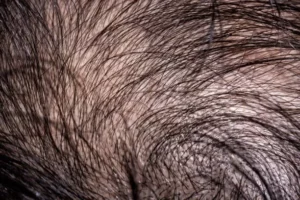
Stress and hair health are closely intertwined, with psychological stress playing a significant role in various hair-related issues. Indeed, once you understand this crucial connection, you’ll be able to manage both your stress and your hair!
Stress leads to the production of cortisol, the body’s primary stress hormone. Indeed, high cortisol levels can have an impact on the hair follicles and may contribute to hair thinning.
Also, stress can also influence the levels of other hormones. For example, stress induces high level of androgens which are associated with hair loss conditions like androgenic alopecia.
Here are some tips that help you reduce your stress levels and the health of your hair.
Lifestyle Changes
You may incorporate some stress management techniques to save your hair. For instance, regular exercise, meditation, deep breathing exercises, and sufficient sleep are very effective to reduce your stress levels. Thus, the impact of stress on your hair health will be reduced.
Scalp Care
Regular scalp massages can improve blood circulation. Therefore, they help you reduce stress and promote hair growth. For instance, using a scalp massager during your wash day can help you maintain a healthy scalp environment.
Healthier and Shinier Hair Tips: Avoiding Harsh Chemicals and Tight Hairstyles
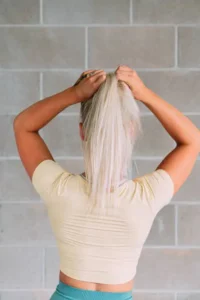
Avoiding harsh chemicals and tight hairstyles is crucial for maintaining healthy hair. Both factors can lead to significant hair damage, breakage, and even long-term hair loss.
Harsh Chemicals in Hair Products
- Damage to Hair Structure: sulfates, parabens, formaldehyde, and certain alcohols, strip the hair of its natural oils. Therefore, these ingredients lead to dryness, brittleness, and breakage. Also, they can weaken the hair shaft, making it more susceptible to damage.
- Scalp Irritation: these chemicals cause scalp irritation. Thus itching and flakiness are inevitable. In severe cases, they even cause dermatitis. An unhealthy scalp environment can negatively impact hair growth.
- Long-Term Health Risks: some chemicals in hair products have been linked to potential long-term health risks. For example, formaldehyde in hair straightening treatments is a known carcinogen.
Here are some healthier alternatives:
- Sulfate-Free Shampoos: opt for shampoos that are free from sulfates, which are harsh detergents that can strip hair of its natural moisture.
- Natural and Organic Products: look for hair products that use natural ingredients. Aloe vera, coconut oil, shea butter, and essential oils are among the best natural ingredients. Indeed, they nourish the hair and scalp without causing damage.
- Avoiding Frequent Chemical Treatments: reduce the frequency of chemical treatments like coloring, perming, and straightening. However, if you want to use them seek out less aggressive options. Also, you must ensure that you visit reputed professionals who use safer products for these procedures.
Tight Hairstyles and Their Impact
- Traction Alopecia: ponytails, braids, buns, and cornrows cause a type of hair loss known as traction alopecia. This condition results from constant tension on the hair follicles. This leads to breakage and permanent hair loss over time if the stress continues.
- Hair Breakage: tight hairstyles lead to hair breakage, especially around the hairline where the tension is greatest. This not only affects the hair’s appearance, but also its overall health.
- Scalp Tension and Pain: Constantly wearing tight hairstyles can cause scalp pain and tension headaches. Also, it restricts blood flow to the scalp, which can hinder healthy hair growth.
Here are some healthier alternatives:
- Looser Styles: opt for looser hairstyles that do not put excessive tension on the hair. For example, you can choose to wear a loose bun, a low ponytail, or braids that aren’t too tight. These hairstyles will help you prevent damage.
- Rotation of Hairstyles: regularly change your hairstyle to prevent continuous stress on the same areas of the scalp. Also, you’ll avoid repetitive tension that can lead to hair loss.
- Use of Protective Styles: protective styles like loose braids or twists can protect your hair from environmental damage while avoiding excessive tension. Just make sure they are not installed too tightly. You must allow your scalp to breathe!
- Gentle Accessories: use hair ties and accessories that are gentle on the hair. For example, you can use those which are made from fabric or soft materials. On the other hand, I advise you to avoid rubber bands or metal clips that can pull and break the hair.
Conclusion: Embracing a Holistic Approach to Hair Care

Achieving healthier and shinier hair is a combination of several habits. Proper nutrition, hydration, and mindful hair care practices can help you achieve healthy and shiny hair.
By following these 8 tips, you can improve the health and appearance of your hair. And you’ll look and feel your best! Moreover, remember, consistency is key. You must incorporate these habits into your daily routine. Give your hair the care it deserves for long-lasting shine and vitality. I guarantee you won’t regret it!
Well, that’s it for today! What do you think of these 8 tips for achieving healthier and shinier hair? Which of these tips do you already apply in your beauty routine? Feel free to share your thoughts in the comments below!
Take care, lovelies!
Want more content from me? Join my newsletter today and receive the latest updates of my website. Also, you’ll receive a wonderful gift in your email!
My recommended book:
Andre Talks Hair by Andre Walker

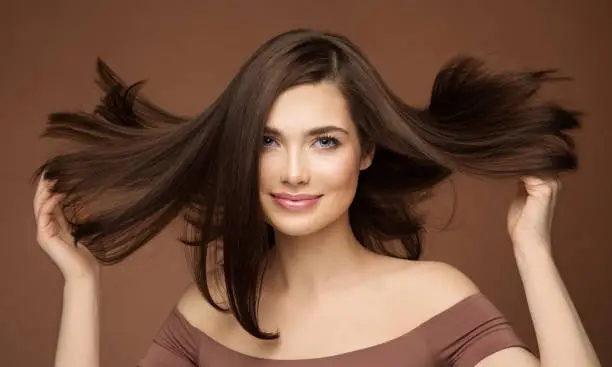
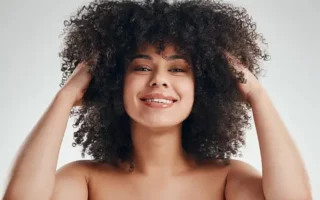


I love how you emphasized the importance of understanding hair type and texture. My hair can be temperamental, and learning to treat it according to its unique needs has been a game-changer. Also, your tip about finishing with cold water after washing is something I swear by! It really does lock in that shine and makes my hair feel so much softer.
I’m also a huge believer in deep conditioning and trimming regularly, it keeps my hair in check. Plus, managing stress is key. I’ve noticed my hair definitely suffers when I’m stressed out, so I’m glad you highlighted the connection between stress and hair health.
Thanks for all the practical tips. I’ll definitely be incorporating more of them into my routine. Looking forward to your next post!
Thanks for your comment Kavitha!
I found your post “10 Tips for Healthier and Shinier Hair” incredibly informative and helpful! The tips you provided, from using gentle hair care products to protecting your hair from heat damage, are all valuable advice that I’ll definitely be incorporating into my hair care routine.
I especially appreciated the tip about trimming your hair regularly to prevent split ends. I’ve noticed such a difference in the health and appearance of my hair since I started doing this.
One additional tip I’d like to suggest is using a hair mask once a week to nourish and moisturize your hair. I’ve found that using a hair mask made with natural ingredients like coconut oil, argan oil, and honey has really helped to lock in moisture and add shine to my hair.
Another tip is to be gentle when towel-drying your hair. Instead of rubbing your hair with the towel, try gently blotting it to remove excess water. This can help reduce frizz and prevent breakage.
Thanks again for sharing your expertise and tips! I’m looking forward to trying out some of the other suggestions you provided.
You’re welcome Cyril!
Wow, what a fantastic read! Your insights on tailoring hair care to specific hair types really resonated with me. I’ve always wondered if different hair types might benefit from unique diets as well—do you think certain foods could specifically help curly hair versus straight hair? Also, your tips on minimizing heat damage got me thinking about air-drying techniques. Have you found any particular methods that work best without causing frizz? It’s great to see someone emphasizing the holistic approach to hair health, including stress reduction. Thanks for sharing such valuable content!
GJ
Thanks for your comment Gabriel! No, I don’t think that there should be different diets for different hair types. it’s just that our hair might be of different textures, but it’s all composed of protein…
You really nailed it with practical tips that anyone can follow, like using a silk pillowcase to reduce friction and split ends. I love how you kept the suggestions simple yet effective—perfect for someone like me who’s always looking for easy ways to improve my hair care routine.
One tip that stood out to me was about avoiding excessive heat styling to prevent damage. I’m curious—what’s your go-to alternative for styling hair without heat? Also, do you have any favorite products that help maintain shine between washes? Thanks for sharing such helpful tips!
Hello thanks for your comment! You just have to air dry your hair, then comb it and style as you wish once it’s dry! To maintain shine between my washes, I enjoy putting some styling lotion, but you should do according to your hair type. Hope that this helps!